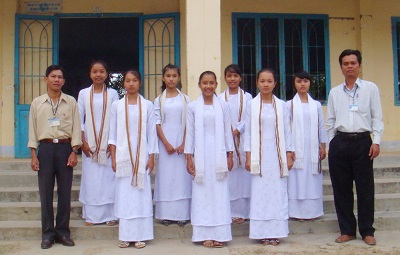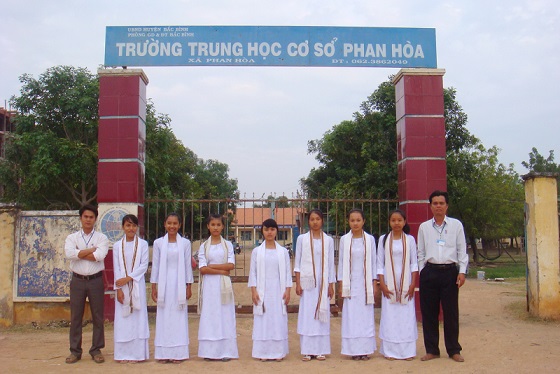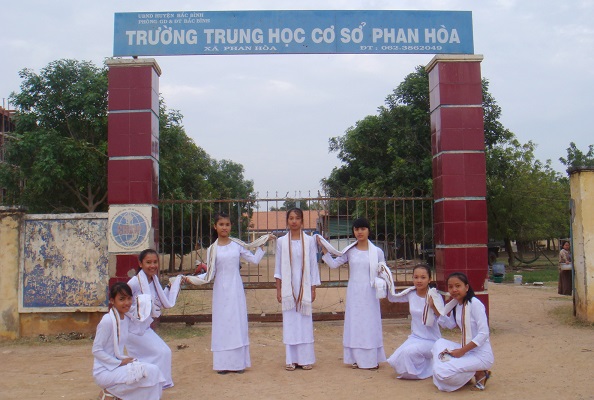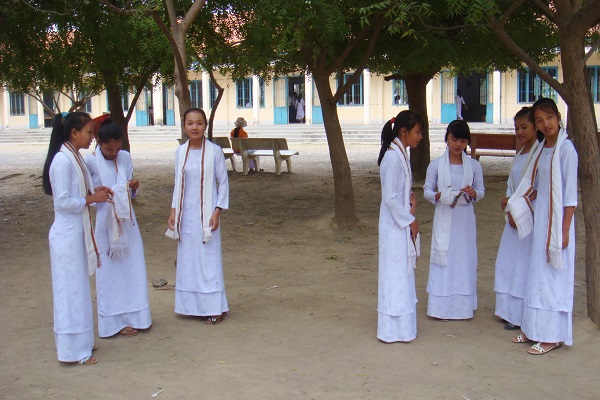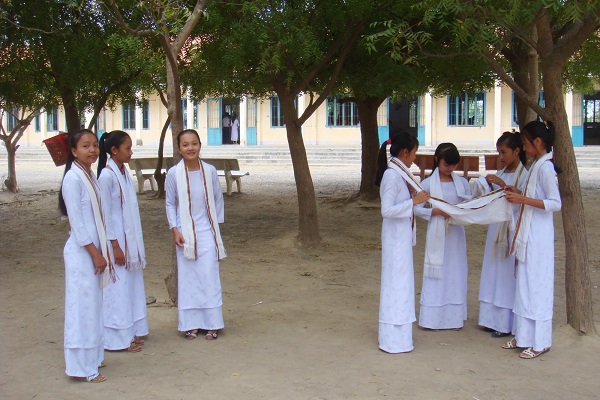Van Ngoc Sang, Mohamad Bin Bilal Ali, Julie Nguyen. A Bitter Conflict about Preservation of Indigenous Cham Scipt in Viet Nam and Negative Effects on Teaching Mother Tongue for Cham Children in School. International Conference on “International Academic Conference”. San Francisco, August 3-7, 2014.
Abstract: Cham ethnic minority in Vietnam today is citizen of ancient Champa kingdom which existed from the 2nd to the 18th century in the South Central region and wiped out from the world map due to the expand of Vietnam. Champa had ever a brilliant civilization in the past and it was known as the most famous architectural tower system that has been remained up to now. Next, the Cham stone statues with sculpture art have reached a climax and Cham script writing system formed from the 4th century and the standardized completely, called as Cham Akhar Thrah in the 16th century by the King of Po Rome.
There have existed conflicts in conservation of the Cham script and lead to the negative result of the Cham language education. Cham children have been encouraged to study the mother tongue up to class 5. While other minorities languages are taught to class 9. So they are easily forgotten and become illiterate again; Especially, the conflict raised doubts in the Cham Youth’s mind when they study the modify Cham Akhar Thrah in school, therefore they have no inspiration or enthusiasm in learning their mother tongue It leads to the result of that the Cham children have been effected psychologically and to be at disadvantage compared with other groups in Vietnam.
From that, the article try to give some solutions to bring the favorable conditions for the Cham children in leaning Cham language based on the role of Education to understand the conflict, finding the caused and give solutions. as follows: The Vietnamese Educational Ministry should have a study to assess again of the modify Cham Akhar Thrah which is used in present schools, look deeply on opinions from other side group; Organization of public dialogue or scientific workshops with participants presented by the Ministry of Education, Department of Heritage, BBSSCC, the Cham elders, Imam dignitaries, intellectuals and students to unify the curriculum and Cham textbooks for Cham children learning; Expanding and improving the programs to lower secondary school, high school and colleges, universities. Implementation and experimental teaching continues to gradually revised annually complete; Except that, teachers and students should be encouraged to participate in researches to develop and preserve the purity of Cham Akar Thrah inside and outside the school.
1. Introduction
Recently, indigenous heritage preservation has become a hot controversial for a long time. Some people argued that ancient heritage should be conserved as original form to keep the own value and appearance the respect with the old generations. Others, however, mentioned that cultural heritage preservation’ objectives should focus on the serve for present livings therefore people can adjust or rebuild the heritage to adapt with the modern life and bring the benefits for the young generation. Hence, there are some conflicts happened and lead to the negative impact on the several walls of life. In order to prevent the conflict, education is considered as the key method with the power effectiveness by enhancing cognitive to understand the conflicts and solve the problem.
This paper discuss about the role of education in preventing the conflict in preservation of culture heritage and application of case study in the indigenous Cham language preservation.
2. Understand the conflict
Conflict is considered a natural phenomenon when it is a catalyst for needed change in order to have a positive result. Conflict usually starts when someone decides that current conditions are unacceptable and need to change. Only one person is needed to start a conflict; others may become involved – whether they wish to or not – in response to this initial impetus for change (Windle & Warren, 1999).
It is important to know factors that contribute to conflict when people need to resolve the conflict. However, in reality there are a variety of factors can contribute, separately or in combination, to cause a conflict with a more complex? Analyzing a conflict to determine what factors are involved can help identify steps that might lead to a solution.
|
Factors contributing to conflict |
Possible Solutions |
Information: Conflicts can arise when people have too little or incorrect information or when they misunderstand the information supplied. |
|
|
Miscommunication: Differences in communication styles may lead the parties to misinterpret the intentions, perceptions, or attitudes of another. As well, the parties may not be aware of the way they come across and the impression they are making |
|
|
Differing values: Differing values may mean that the parties have differing and possibly incompatible goals. |
|
|
Concerns about resource allocation: Resources may be perceived as inadequate. |
|
|
Historical factors: There may be a history of disagreements and/or real or perceived injustices based on the parties’past experiences. |
|
|
Structural factors: Structures exist for parents, schools, and school boards over which they may have little control. This may limit the range of possible solutions for one or more parties. |
|
|
Personal/emotional factors: The need for attention, autonomy, control, power, or recognition may influence the behaviour of one or more parties. |
- identifying the possible needs of participants and attempting to respond to them in appropriate ways while serving the student’s best interests
|
|
Interpersonal factors: Differences in the way the parties approach conflict resolution may lead to a loss of trust. Cultural differences may cause one or more parties to feel that their point of view is not fully understood. |
of others expressing how one feels and demonstrating empathy acknowledging and respecting differences and seeking common ground |
(Source: Adapted from Windle and Warren, Collaborative Problem Solving and Dispute Resolution in Special Education, 1999.)
3. The Role of education in prevent the conflict
Education can play a positive role to resolve the conflict without resorting to violence for establishing peace in the society. Through education qualities like fearlessness, self-control, tolerance, humility should be cultivated which will help in developing proper attitude towards life and a healthy culture of peace.
In support of such preventive strategies, education can contribute to mitigating conflict along the three primary aspects of conflict: structural, behavioral and attitudinal. Education can alter societal contradiction ((structural), improve relations and interactions (behavioral) and courage changes in attitudes in ways that can reduce the risk of conflict and help build sustainable peace. ( UNESCO, 2012)
In structural, Education is a highly visible symbol of Government commitment to its population and serves as a barometer of a state’s commitment to and relationship with its people. (Barakat, Kapinska, and Paulson, 2008) Education has great effect on positive behavior which is key factor to prevent conflict. First of all, school systems combine the interests and objectives of wide range of groups while trying to establish a common underpinning for citizenship. Secondly, Schools and teachers impart the interpersonal, political, social and legal principles that underlie good citizenship. Moreover, classrooms bring together people of different origins and teach them how to work together peacefully. Last but not least, participatory educational process can build relationship inside ans outside school that are built on trust, cooperation and reciprocity. (UNESCO, 2012). Especially, education can change people attitude when they recognized inadequately related knowledge of the problem. Peaceful education has positive effects on students’ attitudes. Teachers can demonstrate positive values, such as acceptance of diversity, kindness and consideration of others’ feelings. And teaching students the values of cooperation and tolerance of cultural differences helps to overcome prejudicial stereotypes that opportunistic leaders routinely use for their own ends (Baraket, Kapinska, and Paulson, 2008)
4. Case study in the preservation of the Cham language heritage
Cham Script is known as one of indigenous languages in Vietnam and has close relationship with family of multi-island "Austronesian", especially Malay. The Cham letters had also appeared on the first stone stele, namely of Dong Yen Chau (Tra Kieu) in the 4th century (Al-Ahmadi, 1988; Coedes, 1939). This evidence allow us to know that in the fourth century, Champa tribes was living in the Tra Kieu and used Cham language at that time to express their ideas. It was up to 16th century when the Cham language have been developed stably and become the main tools in communicate daily and using in several value documents in history, literature, legal documents. These complete works of the Cham script was an effort by Po Rome, a Champa King and this traditional Cham Script is called Akhar Thrah Cham. Since 1832, the Champa Kingdom was wiped out of the world map by attaching of DAI VIET, The Cham languages teaching and learning was not concentrated in the war conditions and went to degenerate. Up to 1978, Vietnamese Government promulgated a policy allowed teaching mother tongue for ethnic minorities’ children in school. From this program, a committee of Cham textbooks' writers was established called BBSSCC and they have modified the traditional Cham script (Cham Akhar Thrah) to make a new system by adding some new syllable of words and respelling of many words following present voices, called modified Cham Akhar Thrah. This way, it will be easier for children who are studying Vietnamese as a general language in all of subjects in Vietnam. However, these have been outcry by the elders, Imam Dignitaries, intellectuals, and students in the Cham community. They argued that these modification were not based on linguist sciences or origin languages as Malay languages, especially, is more risk when broke the stability attribute of the inherent Akhar Thrah system and the children will not inherit the traditional values of Cham culture when they cannot read the old Cham materials. From that a bitter conflict between two trends of preservation of the Cham script happened and has last up to now.
4.1 Describe the bitter conflict of preservation of the Cham Script
In 1994, Dr. Po Dharma, a Cham historical professor working at French, have known as the first person to bring the big problems of preserving Cham Akhar Thrah to discuss in the international conference of preservation of non-object culture in Asian, organized by UNESCO at Hue. His opinion had publicly demonstrating against the BBSSCC’s mistakes in improving the Cham Akhar Thrah.
In 2001, 2002, Nguyen Van Ty and Lo Minh Trai, Directors of BBSSCC attended a meeting of preservation of Cham Script in Kuala Lumpur, Malaysia; 2.2006, Lo Minh Trai continued to attend an international workshop of Script culture in Asian organized at Japan.
Up to September of 2006, an international conference of the Cham language was organized in Kuala Lumpur with 15 participants from BBSSCC, Cham scholars inside and outside Vietnam; Cham dignitaries. The final conclusion of this conference was described in a report of 15 signatures of participants with the main content is that BBSSCC would adjust their Cham script type to Cham Akhar Thrah.
However, when they came back Vietnam they could not do whatever they had discussed from the conference and since this event, a conflict between two different trends started happening with almost 100 papers and emails divides for two sides. Cham language scientists, dignitaries, and students have tried to support for preserve the traditional Cham Akhar Thrah, a convincing evidence is a book of Cham languages – historic form and development established in 2009 and more than 30 linguist papers have been publicly appeared in many websites and language magazines. Writers have tried to analyzed mistake opinions of BBSSCC when they added some new syllable, broken the Cham Akhar Thrah Script system and the most dangerous is young generation will not heritage the ancient value materials storing in Cham village. While BBSSCC are managed by Vietnamese Educational Ministry have been continued implement strictly all of program teaching the Cham language for Cham children in schools. Some of them also try to defend their opinion for teaching and learning Cham languages easier than Cham Akhar Thrah. And they argued that this improve is suitable for development of a language and the opposite side people only want to protest the Cham Akhar Thrah due to politic purpose while another side of people are only desirable in conserving the Cham indigenous Culture.
On Facebook, there are more than 50 conversations between two groups and this bitter conflict have not stopped up to now, especially, bad words are used to swear on others have made a high irritated in the Cham community. Particularly, when Dr. Quang Dai Can attended an international conference in Ha Noi in May, 2013 to protect the Cham modified Script of BBSSCC, a new bitter conflict happened again. Some Cham scholars complained the Vietnamese Educational Ministry have not listened them or work together with them when no Cham language experts attend any important meeting to discuss clearly about preservation of Cham indigenous language. Alone working of power authority for conservation indigenous culture is unfair and illegal the international law of indigenous’ rights. However, these reasons always are argued by authority that it is covered by politic purpose.
4.2. The negative impact of Cham children in learning mother tongue
The most serious impact on the Cham children from the conflict of preserving the indigenous language is that they only learn their mother tongue in primary school, while other children from ethnic minority group in Vietnam learn their mother language up to secondary school.
This phenomenon have leaded to the worse result of most of Cham children have been illiterate again. According to Cao Thanh Xuan (2007), among 300 Cham people in a survey, there have a number of 93,8% Cham people illiterate and re-illiterate of Cham language in the period of 15-20 years age; this number is 91,9% and 81,7% for 21-30 years age and 31-45 years age in sequence. This demonstrated for vast of time and money in investing for teaching Cham language in primary school when most of them re-illiterate when not to continue study in next level of secondary school.
Secondly, most of Cham children have known the conflict of preserving of Cham indigenous language from their parents or other information resources because the Cham community is now become small minority group beside the large Viet Community. Although there are still limits in the ability to realize the complexity involved in this process, but this conflict has been negative impact on Cham children’s psychology and emotion. Most of them like to study the Cham Akhar Thrah because they believe their professors, scholars and dignitaries in their village.
Source: www. Gulpataong
These cause the mistrust thinking in the Cham Youth and maybe one of reasons for learning Cham language in primary school is low effect. Moreover, it exposed an implicit danger for another conflict in the Cham society when the Cham youth lack of belief on their school and whatever they have learned.
Last but not least is that as some Cham scholars predicted, if the Cham youth continue to study Cham language from BBSSCC, the young Cham generation will turn back with their value materials of Champa Kingdom and the Cham ancient people, which were written by Cham Akhar Thrah. This have ruined of conservation of the indigenous culture.
4.3. Solutions to address of the conflict in preserving the indigenous Cham language heritage
As above mentions, analyzing to find the factors caused the conflict is so important to find the solution to address this problem. Focus on the contents and references, this is a complex conflict is effected on several elements.
- : Insufficient, wrong, or misunderstood information: According to Cham scholars, there are many mistakes in the Cham curriculum and text books for Cham children in school today. (Ngon ngu Cham – Thuc trang va giai phap)
- : providing complete and/or accurate information identifying what has been misunderstood and providing clarification. A book with the title of The Cham language, real status and solution, publish in 2011, by 12 writers, most of them are lectures and scholars.
- : Miscommunication: Lack of the meeting between two groups and the Vietnamese Educational Ministry, Cultural Heritage National Conservation
- : organizing meetings, in which participants should listen actively, asking questions to identify and understand assumptions that may need to be corrected, and validating the feelings of others; expressing how one feels and demonstrating empathy.
- : Differing values: When BBSSCC argued that the modified Cham script is easier for students to study and effectively for conservation the Cham language; while others mentioned children cannot read the traditional Cham documents if they study the Cham language of BBSSCC.
- : have meeting to determine of the main goals in conservation of Cham language.
- : Concerns about resource allocation: While BBSSCC based on the resource of Vietnamese language to modify the Cham scripts, others group based on the original language of Cham language is Multi-island Malay language.
- : have meeting to determine of the main language resources which are based on to conserve of Cham language.
- Factor: Historical factors: Cham language is an indigenous language in Vietnam
- : Both of groups should keep an open mind and showing patience and willingness to listen and work to re-establish trust. Need to base the law of indigenous cultural heritage conservation.
Role of Education
Because the conflict in preserving the Cham Script have negative effected on Cham languages teaching in school, therefor education play an important role in the prevent conflict and decrease the injury in Cham children.
Teachers in school should understand deeply about this conflict and continue to inspire students to learn their mother languages to conserve their value own language while all of them are waiting a good decision from authority.
Students need to be enhanced cognitive of their role in using and preserving their own language and they also become a bridge to connect two generations in the Cham Village. When people understand about the reasons of implementing a new program they will have sympathy seeing.
Educational managements should patiently listen from multi-directions to find a best solution avoid injury for the Cham youth generation together satisfied for the several classes people in preservation of Cham script heritage.
5. Discussion and conclusion
What is dynamic for good solutions of protest between two groups is the real effect of the legitimate benefits for Cham indigenous children in learning their mother tongue. A cooperation meeting should be organized with adequate participants for both of groups and the bad word conflicts on internet should be controlled and stopped by enhancing of writers’ responsibility for preventing the negative impacts on children. In order to present a good image nation in the map world, the government needs to conserve the indigenous heritage following the international laws. Nowadays, the conflicts between the indigenous citizens and the government in several countries are popular and become the big waves as implicit protest. Therefore, an effect policy for this problem is based on indigenous’ rights established by UN in 2007. Following this paper, indigenous people are allowed to choose the kind of language for their children to learn. In contrast, if the Vietnamese Government continue to maintain the indigenous language policies that they have done, it is not only would repression of the Cham scholars, dignitaries but also cause a loss of faith from people in a nation, and the international community would also speak out against the government. Only looking at the history, will the government find a good solution for peace, prosperous and sustainable development for own country.
References
- Barakat, B; Kapinska, Z.; Paulson, J. 2008. Desk study: education and fragility, Oxford: Conflict and Education Research Group (CERG)
- Al-Ahmadi, A. R. (1988). Campa dengan alam Melayu. Alam Melayu: Sejarah dan Kebudayaan Campa, Kementerian Kebudayaan dan Pelancongan &, EFEO, Kuala Lumpur., p.73.
- Bien_ban. (2006). Biên bản hội thảo về lịch sử ngôn ngữ và chữ viết Chăm. École française d'Extrême-Orient - EFEO (Conference in Kuala Lumpur).
- Coedes, G. (1939). La plus ancienne inscription en langue chame. Eastern and Indian Studies in Honour of F.W. Thomas. New Indian Antiquary Extra Series I., p. 46-49.
- Dharma, P. (2012). Giới thiệu tài liệu hoàng gia Champa. Viện Viễn Đông Pháp (EFEO).
- Dominique, N. (2006). Chung quanh vấn đề sự chỉnh lý tiếng Chăm sau năm 1978. École française d'Extrême-Orient - EFEO (Conference in Kuala Lumpur).
- Han, P. V. (2006). Akhar thrah với việc cải tiến của Ban Biên Soạn sách chữ Chăm. École française d'Extrême-Orient - EFEO (Conference in Kuala Lumpur).
- Karim, A. (2006). Vấn đề chữ viết Chăm ngày nay. École française d'Extrême-Orient - EFEO (Conference in Kuala Lumpur).
- Liem, T. N. (2006). Vấn đề cải biên một số chữ viết Chăm. École française d'Extrême-Orient - EFEO (Conference in Kuala Lumpur).
- Majid, Y. A., & Sang, V. N. (2013). Từ vựng Mã Lai-Chăm có cùng nguồn gốc. Website Champaka.info.
- Sakaya. (2006). Giáo trình dạy chữ Chămvà hậu quả của việc cải biên ngôn ngữ và chữ viết của BBSSCC Ninh Thuận Việt Nam. École française d'Extrême-Orient - EFEO (Conference in Kuala Lumpur).
- UNESCO (2012), IIEP - Education for conflict prevention and peacebuilding, by Phyllis Kotite.

